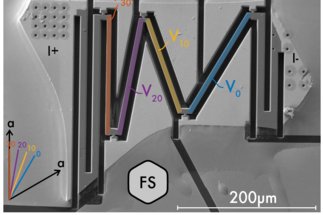Research at PQM
In the following we describe our research through the lens of our individual research groups. In reality, much of what we do is collaborative, both internally and with external collaborators, so anyone thinking of working with us should form a view of our activities from the descriptions taken as a whole rather than by looking at the work of an individual group.
We leverage a suite of synthesis, processing, and characterization tools to understand how the atomic-scale structure and chemistry of crystalline materials give rise to their properties. Our goal is to harness these insights for creative new approaches to materials design.
[more]
We use uniaxial and hydrostatic stress (and the combination thereof) to tune the lattice parameters of correlated electron systems. We apply elastic lattice strains that often exceed 1%, which is enough to strongly alter the electronic properties of many compounds.
[more]
Our group experimentally explores the electronic states of low-dimensional correlated materials. We investigate the transport properties of devices developed with micro-patterning and electrolyte gating techniques, which allow for the possibility to accumulate unprecedented charge carrier densities.
[more]
Using optical methods, we study and directly visualize the breaking of fundamental symmetries in quantum materials with high spatial resolution. We are particularly interested in how external stimuli can drive transitions between broken-symmetry phases.
[more]
In the mescosopic regime, system dimensions are comparable to characteristic length scales of the studied system. Our capabilities for sample-fabrication on the micron-scale give us direct access to many intriguing phenomena, which are not accessible in bulk samples, e.g. quasi-ballistic electron flow in metals.
[more]
Our goal is the discovery of new compounds with intriguing physical properties. The main research fields of our activity are intermetallic compounds with strong electron-electron correlations and complex oxides exhibiting metallic character.
[more]
The research of our team focuses on the experimental discovery and understanding of novel quantum states in strongly correlated electron materials, such as quantum phase transitions, non-Fermi-liquid phenomena and unconventional superconductivity.
[more]
External pressure is an ideal tool to tune quantum and topological materials in a clean and controlled way. We employ magnetic, thermodynamic and electrical transport probes to study emerging unconventional phases at high pressures, low temperatures and in high magnetic fields.
[more]
We study spin excitations and spin dynamics locally at the microscopic level using various complementary resonance techniques (NMR, NQR, ESR). This set of tools gives us direct insight into a variety of systems, where peculiar magnetic order can be observed.
[more]
At the heart of our theoretical research is the study of many-body effects, ordering phenomena, and collective excitations in strongly correlated electron compounds with 3d or 4f/5f elements. To this end, we develop and use various theoretical methods.
[more]









